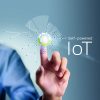Powering the IoT

For centuries, people have been looking for ways to store electrical energy so that it can be used later on. While batteries offer a way to do this, they also have many weaknesses. Energy harvesting, on the other hand, uses sources of energy that are available in the immediate surroundings, anywhere and anytime.
This technology seems to be an essential precondition for the so called Internet of Things – billions of sensor nodes, connecting everything – because there is simply no way to change or even install these number of batteries for economic and ecologic reasons.
The good news: energy is everywhere – just get it!
Energy converters find energy everywhere in their immediate surroundings: in movement, light and differences in temperature. Energy harvesting is aimed at doing this without chemicals and without requiring maintenance. The EnOcean technology currently uses three different types of energy converters.
Energy from motion
EnOcean’s mechanical energy converter ECO 200 converts mechanical energy, the press of a switch for example, into electrical energy. It works similar like a dynamo and makes the energy immediately available. Weighing less than 3 ounces and measuring just over ¼” in height, the smoothly-running converter can be integrated into lightweight, slim-line devices. With an energy output of 120 µWs, a stabilized voltage of 2 V and an according wireless battery-less module, it is possible to transmit three radio telegrams per operation. The return movement delivers another energy pulse. At usual indoor temperatures, more than a million switching cycles are typically completed.
Energy from light
Light is an inexhaustible source of energy. Miniaturized solar modules can even use indoor light to supply electricity for ultra-low power wireless radio modules. An example is the solar-powered STM 330 sensor module. This module is characterized by its extremely low power consumption plus high reliability. If a measured value is transmitted every 15 minutes for example, 3.6 hours of low light indoor charging (200 Lux) are adequate for an uninterrupted operation. An additional PAS type charge capacitor (Poly Acenic Semiconductor) can ensure an adequate power reserve to bridge intervals when little or no light energy can be harvested. With its energy storage mechanism fully charged, the module reliably operates for several days in complete darkness.
Energy from temperature differences
Temperature differences between the air and hot machine parts, radiators or even the human skin contain a lot of energy and therefore are ideally suited to power devices. Thermo generators, so-called Peltier elements, gain the energy without any moving parts, however at very low voltage levels, which requires a tricky voltage conversion. The ECT 310 DC/DC converter already starts to work at 2 °C temperature difference applied to a low cost standard peltier module. An output voltage of more than 3 V is generated from an only 20 mV input in this case. At a temperature difference of 7 °C, approximately 100 μW of electrical power is produced – enough, to even power mechanical actuators as a valve motor several times a day.
Low-energy wireless technology
In addition to efficient energy converters and wireless modules, whose power consumption is particularly low, wireless technology itself forms another important component of energy harvesting. Combined with new generations of chips, the tried-and-tested platform can run different wireless protocols with energy harvesting. As an important prerequisite, the wireless system must be optimized for especially low-power consumption. This applies to the ISO/IEC 14543-3-1X standard established in building automation and as well as to protocols in the 2.4 GHz band, which are used primarily in the consumer market.
Energy harvesting is just starting
Battery-less wireless devices are still new, but already very well established in the field of building automation, of smart home and even for industrial applications. However, the technology is still at the beginning of its possibilities. There are countless other useful applications. I will take a look at these in my next blog article.



